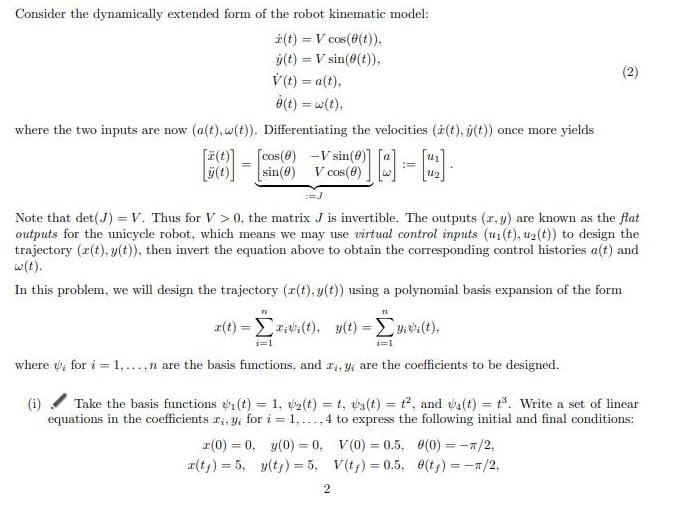Answered step by step
Verified Expert Solution
Question
1 Approved Answer
Consider the dynamically extended form of the robot kinematic model: i(t) = V cos(0(t)), (t) = V sin(0(t)), V() = a(t), %3! (2) (t)


Consider the dynamically extended form of the robot kinematic model: i(t) = V cos(0(t)), (t) = V sin(0(t)), V() = a(t), %3! (2) (t) = w(t), %3! where the two inputs are now (a(t), w(t)). Differentiating the velocities (i(t), (t)) once more yields [#(t)] [cos(0) -V sin(6)] O - sin(0) Vcos(e) U2 Note that det(J) = V. Thus for V > 0, the matrix J is invertible. The outputs (r, y) are known as the flat outputs for the unicycle robot, which means we may use virtual control inputs (u1(t), u2(t)) to design the trajectory (r(t), y(t), then invert the equation above to obtain the corresponding control histories a(t) and w(t). In this problem, we will design the trajectory (r(t), y(t) using a polynomial basis expansion of the form z(t) = Eriv:(t). y(t) = Eu(t), %3D i=1 i=1 where w, for i = 1,...,n are the basis functions, and ri, Yi are the coefficients to be designed. (i) Take the basis functions 1(t) = 1, a(t) = t, ts(t) = t, and va(t) = t. Write a set of linear equations in the coefficients r, Yi for i = 1,...,4 to express the following initial and final conditions: %3D r(0) = 0, y(0) = 0, V(0) = 0.5, 0(0) = -7/2, a(t;) = 5, y(t;) = 5, V(t;) = 0.5, 0(t;) = -T/2, %3D %3D 2 where t = 15. %3D (ii) Why can we not set V(t;) = 0?
Step by Step Solution
★★★★★
3.45 Rating (145 Votes )
There are 3 Steps involved in it
Step: 1
Anscwers Givendata Consiler the dynamicaly extended fom of ...
Get Instant Access to Expert-Tailored Solutions
See step-by-step solutions with expert insights and AI powered tools for academic success
Step: 2

Step: 3

Ace Your Homework with AI
Get the answers you need in no time with our AI-driven, step-by-step assistance
Get Started


